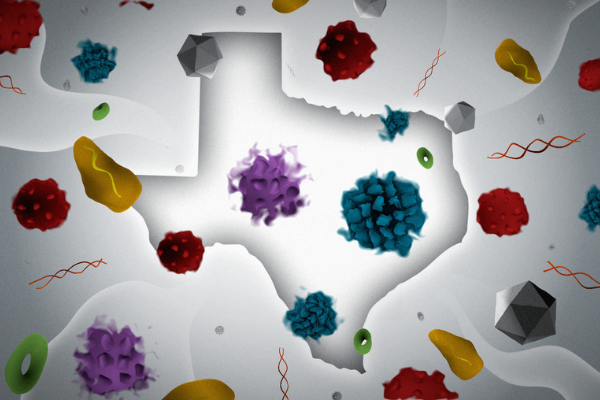
COVID-19’s ability to mutate into faster-spreading variants and subvariants makes it a dangerous moving target for physicians and other health care professionals.
Currently, subvariants BA.4 and BA.5 of the omicron variant make up 66% of cases in Texas, according to the Texas Department of State Health Services (DSHS). Nationally, they make up 81%, according to the Centers for Disease Control and Prevention (CDC).
At both the state and the national level, BA.5 accounts for the lion’s share of cases. Together, these subvariants have created a sixth surge in COVID nationwide. These subvariants display important differences from previous versions of COVID and have changed the character of an ever-evolving pandemic.
Texas physicians attuned to these new subvariant threats recently answered questions from Texas Medicine Today.
How are the BA.5 and BA.4 subvariants different from previous variants of COVID?
They tend to spread faster but be less deadly – at least for people with some COVID antibodies from either vaccination or previous illness or both, says Temple emergency physician Robert Greenberg, MD, a member of the Texas Medical Association’s COVID-19 Task Force. The initial COVID variants had spread more slowly but frequently caused serious respiratory infections. “We’re not seeing that near as much these days – although we definitely see people in the hospital and ICUs. … We’re seeing some with overt respiratory failure and multisystem organ involvement but nothing close to what we saw at the start of the pandemic.”
Does vaccination or previous infection protect against catching BA.4 and BA.5?
No. Vaccines and previous infection offer little protection against infection from these subvariants, says San Antonio infectious disease specialist Charles Lerner, MD, a member of the COVID-19 Task Force. But physicians still should stress the importance of vaccines with patients. “What the vaccines all do is reduce the severity of illness,” he said. Adults who are up to date with their vaccinations are 3.5 times less likely to be hospitalized than unvaccinated adults, according to CDC. Among those who are 50 and older, people who have received two booster shots are 42 times less likely to die from COVID-19 compared with those who are unvaccinated.
Is the importance of vaccination or previous exposure reflected in the COVID data?
Yes. While COVID case counts continue to rise in Texas, reported deaths have risen only slightly or remained unchanged, according to DSHS data. National data from CDC show the same. “The good news is that, at this point, over 95% of our [Texas] population has measurable antibodies to this virus, either because they’ve been infected before or they’ve had vaccines,” said DSHS Chief State Epidemiologist Jennifer Shuford, MD. “So, they are less likely to suffer those really severe outcomes of hospitalization and death.”
What’s the most important thing a physician can do if a high-risk patient tests positive for COVID?
Put the patient on the antiviral drug Paxlovid immediately – if the patient is at an early stage of the infection, Dr. Lerner says. Paxlovid, which helps prevent hospitalization or death by inhibiting viral replication, works best in the first four or five days of an infection. “It’s an antiviral, and once the virus starts to clear [a patient’s body], there’s no point in giving the drug,” Dr. Lerner said. COVID antibody infusions have a negligible effect against BA.4 and BA.5, and recent laboratory tests show COVID can mutate in ways that make Paxlovid less effective as well. The drug is still useful, but it might not be for long, Dr. Lerner says.
Is masking still important?
Yes, masking still is recommended by CDC. But many people are tired of using masks, and health care professionals debate the practicality of trying to convince reluctant patients to wear them rather than asking them to practice other mitigating behaviors such as avoiding large gatherings, Dr. Greenberg says. Physicians, nurses, and other health care professionals wear masks to avoid spreading the virus to others or becoming sick themselves when there already is a chronic shortage in these positions. “The big issue right now is that [COVID] is impacting our workforce – it’s the number of physicians and nurses and other health care providers who are turning COVID-positive after having avoided infection for the last two years,” he said. “To take care of our patients and ourselves, we still need to try to keep from getting infected.”
Will other variants and subvariants replace BA.4 and BA.5?
Yes. Several variants and subvariants are spreading rapidly in different parts of the world, Dr. Lerner says. It’s unclear if any of these will challenge the dominance of BA.4 and BA.5 in the U.S. But given COVID’s ability to mutate, a new dominant variant is inevitable, he says. The good news so far is that all the mutations have made COVID somewhat less deadly, but that could change as well. Vaccine makers are racing to create a “pan-coronavirus” vaccine that targets the “conserved” parts of the coronavirus – the parts that usually don’t mutate, Dr. Lerner says. Such a vaccine “would be a game-changer because that would protect you against all the [COVID-19] variants and all the other coronaviruses,” he said.